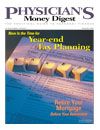Publication
Article
Physician's Money Digest
Break the Vicious Paycheck-to-paycheck Cycle
The number of householdsliving from paycheck topaycheck is staggering.According to a recent surveyby MetLife, nearly60% of the households in America withchildren under age 18 and over half ofthose nearing retirement depend ontheir latest paycheck to meet expenses.And this isn't a problem just for thenation's poorest. The same surveyfound that one third of workers earning$75,000 or more a year live from onepaycheck to the next.
There's no magic way out of thispredicament. It takes hard work andit's not fun. But it's even less fun livingon the edge, waiting for a crisis todestroy what remaining financial safetyyou have. One key, beyond findingbetter-paying work, is to spend lessthan you earn and sock away thatextra money to help cover a financialemergency. The ideal way is to build areserve of 3 to 6 months' worth ofbare-bones living expenses. That's atough assignment for households barelymaking it to the end of the month,so start small. A 1-month reserve oreven a few hundred extra dollarswould be a big step. How can youbuild a small financial reserve?
Formulate a Plan
Few families living paycheck to paycheckhave any kind of financial plan.They stumble from one month to thenext without a clue where their paycheckgoes, often running out of cashbefore the month ends. A formal spendingplan tracks your spending andestablishes a list of priorities so thatessentials get paid first and nonessentialsget paid only if there is enoughmoney left. A spending plan requiresperseverance and diligence, especiallytracking small cash expenditures, suchas coffee, lottery tickets, or entertainment.You'll be surprised where yourmoney is going each month and howmuch of it is going there.
With a budget in hand, it's time toopen a bank savings account or moneymarket where you can stash your savings,however small they may be atfirst. Don't leave emergency fundslying around at home in a cookie jar.It's not only vulnerable to theft, it's farmore vulnerable to impulsive spending.The easiest method is to have themoney automatically taken out of yourpaycheck every month and depositedin a savings account or money market.The question, naturally, is where doyou scrape up the extra dollars?
Items Add Up
Look again at where you're spendingyour money, starting with the littlethings. How much are you spendingon lattes, lunch, magazines, cigarettes,drinks, movies, and so on? You don'twant to deprive yourself of all fun, butsurely some small luxuries can be cutback or eliminated. Each item mayseem small, but they add up. A $3 coffeeevery day is $90 a month. Puttogether several items like that andyou're talking about real money.
Don't stop with the little stuff.Amazingly, people will cut smallexpenses and use coupons and shoparound to save $25 on an item, yetoverlook larger expenses where theycan save bigger bucks. For example,when was the last time you shoppedfor cheaper car insurance? Do youreally need $100 worth of cable amonth? Cut it back to $40 and yousave $720 a year—enough to pay foran emergency car repair or make amonth's rent if you're out of work.
Reduce the number of credit cardsyou have. It's easier to lose track of howmuch you're spending when you useseveral cards. Or get rid of your cardsaltogether. Breaking the paycheck-to-paychecktreadmill isn't easy, but mosthouseholds can do it with smart planningand a little will power.
This article has been produced by the Financial Planning
Association (www.fpanet.org), the membership organization
for the financial planning community.
